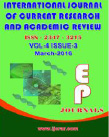Abstract Volume:4 Issue-3 Year-2016 Original Research Articles
 |
Online ISSN : 2347 - 3215 Issues : 12 per year Publisher : Excellent Publishers Email : editorijcret@gmail.com |
2Department of Animal Biology, Vegetable Biology and Ecology, Universidad de Jaén (Spain)
Semi deciduous dry forests in southern Ecuador are valued internationally for their conservation significance, and important locally as a source of timber for agroforestry. Data with which to evaluate the compatibility of these interests is currently lacking. In permanent sample plots (PSP) established according to a simple random design, 12 species were found, representing 12 genera and 11 botanical families. The ecological analysis was performed by determining the basal area, height, density, frequency, dominance, IVI and FIV. The most diverse families are Burseraceae, Bignoniaceae and Caesalpiniaceae. However, the species with the highest IVI are: Bursera graveolens, Tabebuia chrysantha and Caesalpinia glabrata. The basal area of the species studied was 11.4 m2 ha-1 with a volume of 66.35 m3 ha-1. The size class distribution for most tree/species highlighted the absence of the large/order individuals, which reflect the disturbance of the forest. Aboveground biomass was estimated and the carbon found was 68.06 Mg ha-1, with an amount of 33.04 Mg ha-1 of carbon stored, results that are within normal ranges for the seasonally dry tropical forests. This study provides important baseline information on the species composition of the forest as well as the conservation status of species.
How to cite this article:
Vinicio Carrion-Paladines and Roberto Garcia-Ruiz. 2016. Floristic Composition and Structure of a Deciduous Dry Forest from Southern Ecuador: Diversity and Aboveground Carbon Accumulation.Int.J.Curr.Res.Aca.Rev. 4(3): 154-169doi: http://dx.doi.org/10.20546/ijcrar.2016.403.017



Quick Navigation
- Print Article
- Full Text PDF
- How to Cite this Article
- on Google
- on Google Scholor
- Citation Alert By Google Scholar
